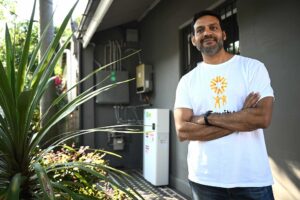You would think that with all the hoo-ha about the scandalous increases in electricity prices that it would have rated some sort of mention in the budget. You know, one of the biggest cost inputs for business being addressed in the government’s economic centrepiece.
But no. The 2nd Morrison/Turnbull fiscal document blithely ignores the issue, despite the fact that their lack of policy direction in the last few years has been the major contributor to the price surges that are scorching household and business budgets.
There’s some pointless extra money for coal seam gas, the removal of some funds for carbon capture (finally) and some previously promised funds for solar thermal (about time), and even another thought bubble on Snowy Hydro – this time to buy it out from the state governments. See Matt Rose’s article for more details.
But there is nothing on climate change, no grand vision on energy. There are no new funds for the Direct Action policy that Turnbull had once ridiculed as a fig leaf for a climate action, and nothing on what might take Australia along the path to the pledge it signed in the Paris deal – effectively to reach zero net emissions by 2050.
As Labor’s Mark Butler noted this morning, the Coalition’s climate change policy has officially gone from that fig-leaf to a non-existent farce.

Nearly three years after celebrating the dumping the carbon price (above), slashing the RET and ignoring expert advice (CCA and the Climate Council), the Coalition government has no actual policy, on energy or climate, and its negligence is adding to the stunning rise in electricity prices it is trying to blame on everything and everyone else.
“Malcolm Turnbull, the Prime Minister who once said he didn’t want to lead a Liberal Party that didn’t feel as strongly about climate change as he did, is now the Prime Minister who has completely dropped any pretence of attempting to combat climate change,” Butler says in his statement, noting that climate change did not rate a single mention in the Budget speech.
“As the central pillar of the Direct Action policy, the Emission Reduction Fund, runs out of funds, this budget delivers ZERO new policies or funding to drive down pollution and combat climate change. This budget allocates more new money to the Department of the House of Representatives than it does to tackling climate change.
“Budgets are about choices and priorities, and this budget makes it perfectly clear the Turnbull government isn’t choosing a safe climate because they don’t think it is a priority. This budget finally makes official what we already know; this Liberal government is failing all future generations of Australians.”
We took big slabs of Butler’s comments because we don’t think we could say it any better.
Ostensibly, the Coalition government is waiting for the results of the Finkel Review, and its own review into climate policy, or any of the other 24 different reviews whose outcomes it may find convenient.
Turnbull’s also waiting to sniff the breeze out of Washington, which is likely to be foul, and could amount to a complete withdrawal or at very least a two-fingered salute, something that his f***-you picks as head of the EPA and the energy department have all but guaranteed.
And then Turnbull has to consider the right wing of his own party, and the date in September when it will come to pass that he has served a day longer than his predecessor Tony Abbott, when we can only hope that we might see the emergence of Turnbull 2.0.
For the moment, the Coalition’s stance is untenable. It has suggested that “clean coal” might be the answer, but that idea – on both the notion that this coal might be clean or economic – has been hit out of the ball-park by all but a handful of market opportunists.
Gas is quickly being discounted too. The monies allocated for pipeline and C&G research are yet more fig leaves. Gas will play some role as a “peaking plant” and a “gap filler” over the next decade or two, but the idea of gas being a transition fuel has also been belted out of the ball-park, by the gas producers themselves.
AGL Energy says it is simply too expensive and can’t and won’t be able to compete with the stunning falls in wind, solar and battery storage technologies. Origin agrees, particularly after signing a long-term agreement to buy the output of the 530MW Stockyard Hill wind farm for just $55/MWh.
Santos is signing up for solar plants because it might be the cheapest way of freeing up more gas, which is just one small light in a gas business strategy that is based around an untenable, f*** the next generation, 4°C climate strategy.
The Finkel Review, like the CSIRO/ENA reports that preceded it, and the new thinking coming out of the Australian Energy Market Operator, and the major utilities, will likely tell us that the transition to zero net emissions is both possible, imperative, and likely to cost a lot less than most people think.
The trick will come in the policy suite that is deemed best to reach that target. One is the emissions intensity scheme, but this was largely designed as a free kick for a technology (gas) that is now longer considered necessary.
That can be solved, perhaps, with a really biting EIS, or perhaps more effectively by adopting state-style renewable energy schemes and having a managed transition through a series of auctions, the policy of choice in many other countries.
The idea that Turnbull is now considering buying out Snowy Hydro, completely, suggests the latter may be an option. Current market settings and rules clearly don’t work because the price of electricity is preposterously and unnecessarily high.
As this graph shows, the average price has more than doubled over the last year. At times, the rise has been three or four-fold, particularly when the incumbents were able to take advantage of their market power in South Australia and Queensland.
That has the single happy outcome of making distributed generation – rooftop solar and battery storage – very popular.
But as the CSIRO and the networks point out, that could have unintended consequences if power prices stay high and the technology costs of solar and storage continue to fall to the levels anticipated by South Australian Power Networks, of just 15c/kWh, or less than half of their bills.
That could cause a stampede out of the grid just at a time that the equipment installed by households and business should be harvested to add to the power and security of the grid.
As so many people are saying, this is going to require some smart technologies, and some smart policies. There is absolutely no sign of the latter from this government yet.
Then again, this budget does jettison the conservative ideology on small government. Perhaps it can also dump – with or without permission from the IPA – its antipathy on climate change, and do energy consumers a favour by accelerating, not slowing, the inevitable energy transition away from centralised fossil fuels.









